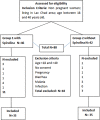Vitamin A status in healthy women eating traditionally prepared spirulina (Dihé) in the Chad Lake area
- PMID: 29377934
- PMCID: PMC5788361
- DOI: 10.1371/journal.pone.0191887
Vitamin A status in healthy women eating traditionally prepared spirulina (Dihé) in the Chad Lake area
Abstract
Background: Chad Lake is a central place in a region with a high prevalence of vitamin A deficiency. Spirulina, a natural source of β-carotene, is traditionally produced and eaten as "Dihé" around Chad Lake. β-carotene spirulina has been found to have a high conversion factor to retinol. The aim of the study was to assess if the retinol status between healthy women eating spirulina Dihé daily (SPI+) and not (SPI-) in the Chad Lake area was different.
Methods: This study was observational: 88 healthy women were recruited and selected according to clinical criteria and their willingness to participate. They were divided in two groups according to their Dihé daily consumption: those who eat Dihé (SPI+; n = 35) and those who do not (SPI-; n = 35). After anthropometric and dietary assessments, blood retinol, β-carotene, retinol binding, and inflammatory/nutritional proteins were measured.
Results: The diet between groups was identical, except for β-carotene consumption, which was higher in SPI+ than in SPI- (10.8 vs. 1.8 mg/day). The serum retinol and β-carotene concentrations were significantly higher in SPI+ than in SPI- at 1.26 ± 0.36 μmol/l versus 1.03 ± 0.31 μmol/l (p = 0.008) and 0.59 ±0.37 μmol/l versus 0.46± 0.31 μmol/l (p = 0.04), respectively. Seventy-seven percent of SPI+ versus 29% of SPI- had an adequate blood retinol value (p = 0.01).
Conclusion: The results confirm that β-carotene in spirulina is an effective positive modulator of blood retinol status. Dihé is a potential natural source of β-carotene to achieve a proper vitamin A status in healthy women living near Chad Lake.
Conflict of interest statement
Figures




References
-
- Tang G, Qin J, Dolnikowski GG, Russell RM, Grusak MA. Golden Rice is an effective source of vitamin A. Am.J.Clin.Nutr. 2009; 89:1776–1783. doi: 10.3945/ajcn.2008.27119 - DOI - PMC - PubMed
-
- Benn CS, Aaby P, Arts RJ, Jensen KJ, Netea MG, Fisker AB. An enigma: why vitamin A supplementation does not always reduce mortality even though vitamin A deficiency is associated with increased mortality. Int J.Epidemiol. 2015; 44: 906–918. doi: 10.1093/ije/dyv117 - DOI - PMC - PubMed
-
- Mason J, Greiner T, Shrimpton R, Sanders D, Yukich J. Response to: Letter to the editor by Benn C, Fisker A and Aaby P. Int J.Epidemiol. 2015. a; 44: 367–368. doi: 10.1093/ije/dyu266 - DOI - PubMed
-
- Mason J, Greiner T, Shrimpton R, Sanders D, Yukich J. Vitamin A policies need rethinking. Int J.Epidemiol. 2015. b; 44: 283–292. doi: 10.1093/ije/dyu194 - DOI - PubMed
-
- Mason JB, Sanders D, Greiner T, Shrimpton R, Yukich J. Vitamin A deficiency: policy implications of estimates of trends and mortality in children. Lancet Glob.Health. 2016; 4, e21 doi: 10.1016/S2214-109X(15)00246-6 - DOI - PubMed
Publication types
MeSH terms
Substances
LinkOut - more resources
Full Text Sources
Other Literature Sources
Medical

